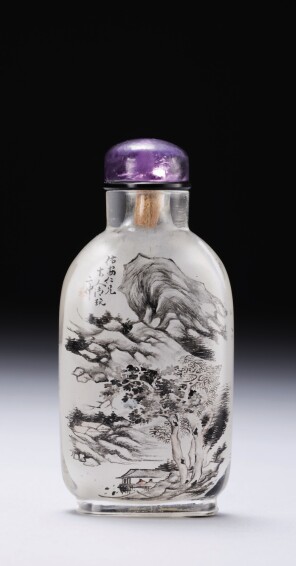- 6
1897年 丁二仲作玻璃內畫山水圖鼻煙壺 「仿安仁兄古人清玩」字 《二仲》款
描述
- 「仿安仁兄古人清玩」字 《二仲》款
- glass
來源
Eric Young 收藏
倫敦蘇富比1987年3月3日,編號148
展覽
《Kleine Schätze aus China. Snuff bottles—Sammlung von Mary und George Bloch erstmals in Österreich》,Creditanstalt,維也納,1993年,頁10
出版
Hugh Moss、Victor Graham 及曾嘉寶,《A Treasury of Chinese Snuff Bottles: The Mary and George Bloch Collection》,卷4,香港,2000年,編號546
Condition
"In response to your inquiry, we are pleased to provide you with a general report of the condition of the property described above. Since we are not professional conservators or restorers, we urge you to consult with a restorer or conservator of your choice who will be better able to provide a detailed, professional report. Prospective buyers should inspect each lot to satisfy themselves as to condition and must understand that any statement made by Sotheby's is merely a subjective, qualified opinion. Prospective buyers should also refer to any Important Notices regarding this sale, which are printed in the Sale Catalogue.
NOTWITHSTANDING THIS REPORT OR ANY DISCUSSIONS CONCERNING A LOT, ALL LOTS ARE OFFERED AND SOLD AS IS" IN ACCORDANCE WITH THE CONDITIONS OF BUSINESS PRINTED IN THE SALE CATALOGUE."
拍品資料及來源
The superbly painted landscape of the other side is a transitional one between the style of Sale 2, lot 54 and the much more abstract Sale 9, lot 193. Although the style of painting is similar here to the first, with its more integrated linear approach where lines blend into each other to form the mass of the mountains, the composition is becoming much more abstract. Ding has now broken down his mountain forms into balancing elements of dark and light, large and small. This is particularly noticeable in the use of the smaller rounded rocks that are dotted about the landscape more as a formal element than as small boulders, although they serve as both.
In what is essentially a monochrome landscape painting, despite the coloured robes of the figures, Ding has added one small wash of blue high on the left-hand side of the group of trees above the red-robed figure. It cannot have been accidental and is so strange an anomaly in an otherwise ink landscape that it can only represent breath-taking confidence.
There appears here the studio name Shiqishu meihua shanfang, (Mountain Abode of Seventeen Prunus Trees), which was first used by Ding in the previous year, 1896. It seems that Ding kept this studio name when he moved from Beijing to Nanjing, probably in 1900, since he continued to use it on bottles as late as 1906.

